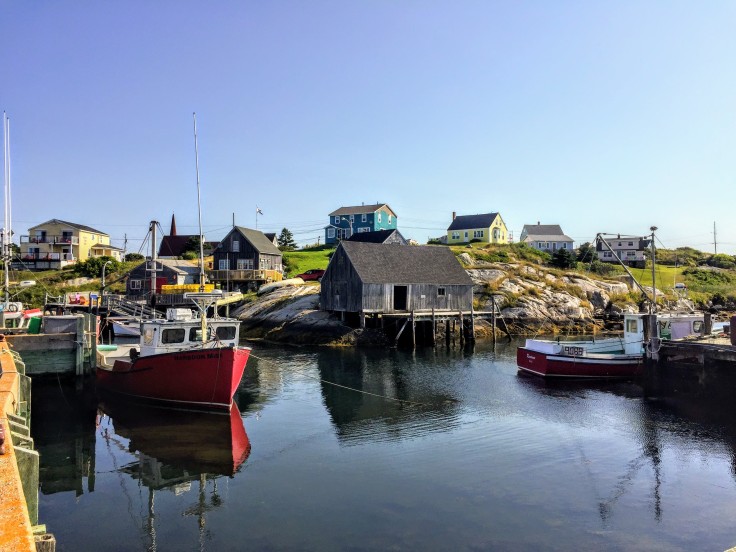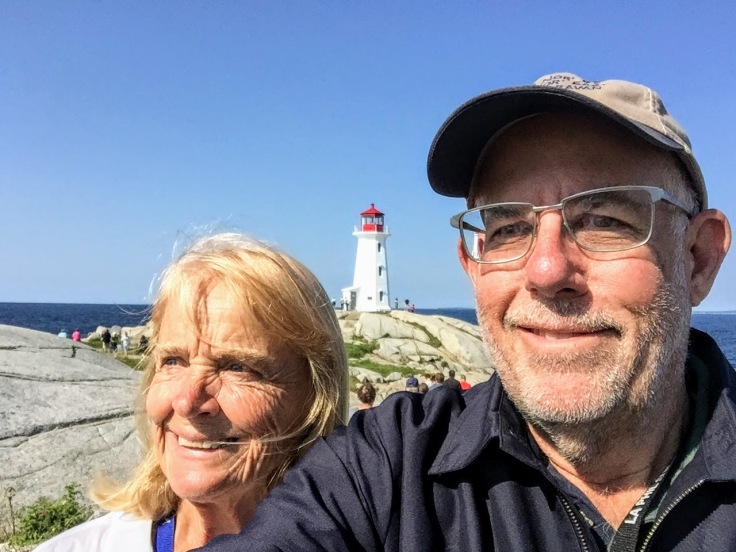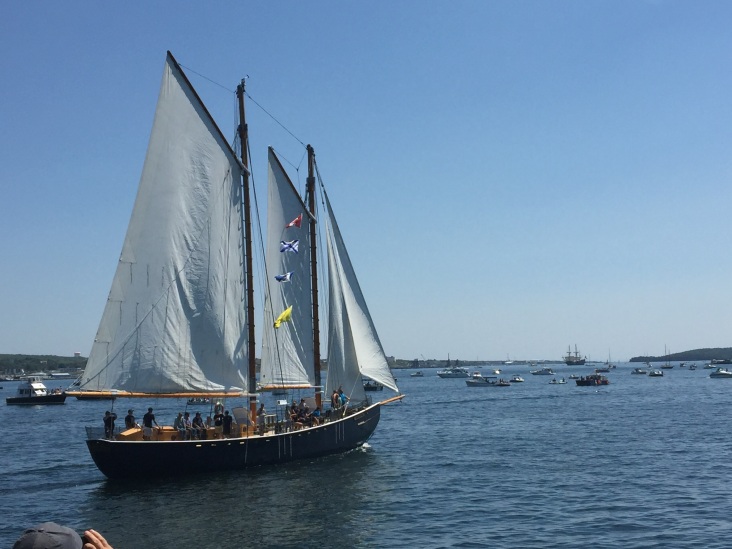Most of Nova Scotia is a large peninsula, attached to New Brunswick by a 12 mile wide isthmus. In addition, to the northeast is a huge island, Cape Breton Island. Halifax is on the South Shore of the peninsula; this is where we are going today.

The bus picked us up at the campground at 8:15 this morning. We had a very knowledgeable tour guide, a native of Halifax and a former school teacher. Shortly we were cruising along St. Margaret’s Bay, a lovely bay on Nova Scotia’s South Shore, lined with picturesque coves. Unfortunately, we were sitting on the wrong side of the bus, so we have no drive-by photos to show you…
But then we arrived at Peggy’s Cove. It has picturesque written all over it. The hamlet of Peggy’s Cove is home to a few hearty lobster fishermen and the required number of down home artists. There are a few shops selling trinkets and puffin-watching boat tours, and a HUGE restaurant, packed on this morning with tourists having breakfast. Oh yes – there is also a lighthouse…
Our bus driver parked our huge bus amongst the other huge tour buses:

We clamored over the rocks to see the lighthouse up close and personal. It is a marvelous sight – perched out there on the open Atlantic, anchored into the rock…




Signs everywhere warn you to stay off the black rocks – they are submerged at high tide, and thus are wet and slimy and slippery. So far two people have died this year slipping and falling into the water. Due to rough waves and cold water, rescue is virtually impossible…
Here I am, safely on the white rocks:

The rocky shore is a sight to behold:


We also walked through the town and found interesting sights:




And, of course, the church:

There is a Fishermen’s Memorial, carved by a long time local artist into a wall of solid granite in the side yard of his house:


One more selfie at the lighthouse:

After 1 1/2 hour, our tour continued as we drove into Halifax. Along the way we heard of the history of the town, and about it’s renowned hospitality to those in need. We arrived at the Maritime Museum, but we opted not to go in at this time; we walked down to the waterfront to see the Tall Ships parading about the harbor, under full sail.

Halifax has a HUGE harbor – most of it is beyond what we see at this waterfront location. We found a restaurant for lunch and were blessed with a water-front table. As we ate our lunch we could see the ships sail by. They sailed out of the harbor, then back in, getting themselves arranged in some semblance of order, then they circled the harbor once again. On the final trip around, they headed out to sea; they are going to Louisbourg, NS, which is our next stop on this caravan.
They have a lot of construction going on here on the waterfront, so they built a temporary floating boardwalk to keep the waterfront path continuous. It is a real challenge, especially when a big ship goes by, and its wake hits the floating boardwalk, then everyone sees another Tall Ship and rushes to one side… It feels like it is going to tip over:

Our lunch at Murphy’s:

And being photo-bombed by Kathy:

So after a pleasant lunch and more big sailboats that anyone can handle, we went back into town and toured the Maritime Museum, which was interesting… maybe they should have named it the Disaster Museum…?
Several disasters have impacted the hearts and souls of the residents of Halifax. In addition to the requisite shipwrecks and fishermen who were lost at sea, in 1912 Halifax was the best port into which to bring both the survivors and the victims of the sinking of the Titanic. Halifax was chosen because, being on the mainland, it has a direct railroad connection to the rest of North America. (Newfoundland was closer, but, because it is an island, logistics would be a problem…)
The doctors and other personnel devised a system of numbering the victims via toe-tags and keeping records of their statistics and personal effects that is still used today. Because of this, MOST of the victims have been identified; some research with DNA is going on today to identify the few remaining unknowns. The most remarkable:

Sidney Leslie Goodwin (9 September 1910 – 15 April 1912) was a 19-month-old English boy who died during the sinking of the RMS Titanic. His unidentified body was recovered by the ship Mackay-Bennett after the sinking, and for decades was referred to as The Unknown Child. His headstone read “Erected to the memory of an unknown child whose remains were recovered after the disaster to the Titanic April 15th 1912”. Previously, the remains of two other children were tentatively identified, but these proved to be false. In 2008, mitochondrial DNA testing by the Armed Forces lab revealed his identity. Baby Goodwin is the only member of his family whose body has been recovered and subsequently identified.
Where did we learn all this? At the Fairview Cemetery, where 121 victims of the Titanic are buried:


While many of the bodies were shipped home to their families, many were buried here. In addition to the grave of the “unknown child”, here is the grave of J. Dawson:

No, this isn’t Jack Dawson from the Titanic movie – he is fictional. This is Joseph Dawson, a crew member who worked below decks as a coal trimmer, about the most lowly shipboard job there is – raking the burning coal that provided the steam to power the engines…
Want more?
On the morning of 6 December 1917, the SS Mont-Blanc, a French cargo ship laden with high explosives, collided with the Norwegian vessel SS Imo in the Narrows, a strait connecting the upper Halifax Harbour to Bedford Basin. It was a simple fender-bender, but fire broke out on board the French ship; the French crew immediately ran (and rowed) for cover, as the ship drifted towards the docks of Halifax. The fire ignited her cargo, causing a large explosion that devastated the Richmond district of Halifax. Approximately 2,000 people were killed by blast, debris, fires and collapsed buildings, and an estimated 9,000 others were injured. The blast was the largest man-made explosion prior to the development of nuclear weapons, releasing the equivalent energy of roughly 2.9 kilotons of TNT. Many of the injured were blinded by shards of flying glass, moving with such force that the victims were unable to blink. In addition to the blast, the air was now filled with oil, gunpowder residue, and other chemicals; if you were injured by flying glass or other cuts and abrasions, your wound was infused with this blueish melange; as a result, as the wound healed, the scars took on a blue tint. From then on, victims of the Halifax Explosion were easily identified by their “blue tattoos”…
Once again, the citizens of Halifax responded, caring for the wounded and identifying the dead, using systems devised for the Titanic. Relief efforts began almost immediately, and hospitals quickly became full. Emergency shelters were erected, but an unexpected blizzard claimed many more lives, adding insult to injury… Many victims of the Halifax Explosion are buried in a mass grave at the Fairview Cemetery.
But wait! There’s more!
Swissair Flight 111 was a scheduled international passenger flight from New York City, to Geneva, Switzerland. On September 2, 1998, the McDonnell Douglas MD-11 crashed into the Atlantic Ocean southwest of Halifax International Airport at the entrance to St. Margarets Bay, Nova Scotia. The crash site was five miles from shore, roughly equidistant from the tiny fishing and tourist communities of Peggys Cove and Bayswater. All 229 passengers and crew aboard the MD-11 died. The ground search and rescue operation was handled by teams from Halifax. There is a memorial to Swissair Flight 111 near Peggy’s Cove. However, it is intended only for family members, so no parking facilities are provided for tour buses…
And, finally:
After the 911 attacks, the US halted all air traffic over the USA. Inbound flights needed to land, and over 60 jets filled with passengers landed at Halifax airport. 12,000 passengers were now on the ground; this is over 3 1/2 percent of the population of Halifax. As all the hotels and motels quickly filled, and as emergency shelters in high school gymnasiums were overwhelmed, Halifax residents opened their doors, inviting the “plane people” to stay in their homes. Similar situations occurred all over Newfoundland and other parts of Eastern Canada, but we’re in Halifax, so we point out and appreciate their hospitality.
After a moving afternoon in the cemetery, toured the Public Gardens:

Very formal, very symmetrical, and very Victorian…
We finally returned to campground; Happy Hours ensued and an enjoyable time was had by all.



